
safety with acrylic PDF
Preview safety with acrylic
~@ ®@[Ji])® W@[f[k®~@[P) [P)~®©~~©®® ~mlclli(!J]®~~~®~ [p)[f@©®®®®® Acknowledgments This document was produced in collaboration with the Education Liaison Group and other leI staff onTeeside, who assisted with the technical details and provided support. for printing and the teachers involved. Out ofprint Ifll and ESPI booklets provided a framework ofinformation which was built upon by the working party. The cover photographs were supplied by leI. Members of the Working Party Don Raspin - Education Liaison, ICI Keith Waugh - Development Officer, Design and Technology, Cleveland L.E.A. Polly Brettle - Advisory Teacher, Design and Technology, Cleveland L.E.A. Paul Bennington -Head of Technology, Ormesby School, Cleveland David Barrass - Head ofTechnology, Hartlepool Sixth Form College, Cleveland Editor Alan Stan cliffe Polymer Industry Education Centre Department ofChemistry University of York Heslington York Y015DD Telephone (0904)432523 © Jointly held by ICI and the University ofYork Published 1994 ISBN:185342700 4 The copyright holders waive the copyright onthe material which follows to the extent that teachers may reproduce this material for use with their pupils in the establishment for which the material was purchased, but for all other purposes permission to reproduce any ofthis material in any form must be obtained from leI orthe University ofYork. The material may not be duplicated for lending, hire or sale. CONTENTS Page Introduction SECTION1 SCHOOLBASEDPROCESSES 1.1WORKSHOPPRACTICE 1 1.1.1 Storage 1 1.1.2 Protective masking 1 1.1.3 Static electricity 1 1.2SAFETYWITHACRYLIC 2 1.2.1 Handling and machining 2 1.2.2 Flammability 2 1.2.3 Pressure shaping 2 1.3FABRICATIONPROCESSES 3 1.3.1 Safety 3 1.3.2 Perspex acrylic sheet 3 1.3.3 Marking out 3 1.3.4 Edge treatment 3 1.3.5 Cutting straight lines 4 1.3.6 Cementing 5 1.3.7 Machining 7 1.4SIMPLETHERMOFORMINGTECHNIQUES 8 1.4.1 Effect of moisture 8 1.4.2 Oven heating 8 1.4.3 Single curvature forming 9 1.4.4 Double curvature forming 11 1.5VACUUM FORMING 13 1.5.1 Equipment 13 1.5.2 Moulds 14 1.5.3 Heating times 15 1.5.4 Cooling times 16 1.6FLUIDBEDCOATING 17 SECTION2 INDUSTRIALBASEDPROCESSES 2.1PROCESSINGMETHODS 18 2.1.1 Extrusion 18 2.1.2 Balloon blowing 19 2.1.3 Calendering 20 2.1.4 Injection moulding 2 1 2.1.5 Thermoforming by pressure 22 2.1.6 Thermoforming by vacuum 23 2.1.7 Biaxial stretching of film 24 2.1.8 Glass Reinforced Plastics Lay-up and Moulding 25 2.1.9 Plastic laminates 27 2.1.10 Compression moulding 28 2.1.11 Rotational moulding 29 2.1.12 Extrusion blow moulding 30 2.1.13 Injection stretch blow moulding 3 1 2.1.14 Dip moulding 33 2.1.15 Structural foam moulding 34 1 APPENDICES Appendix 1 Properties and applications - Thermoplastics 35 Appendix 2 Properties and applications - Thermosets 36 Appendix 3 Physical properties of some thermoplastics 37 Appendix 4 Chemical resistance of some thermoplastics 3 8 Appendix 5 Summary of main industrial processes 39 Appendix 6 Equipment and materials suppliers 40 Appendix 7 Other resources 4 1 Trade names and abbreviations associated with different materials are included in the tables listed above. 11 Introduction This booklet has been produced in response to enquiries from teachers of Design and Technology seeking information on working practices in industry and schools relating to thermoplastics. It is not an exhaustive reference guide but does provide an introduction to basic techniques suitable for schools and the more common processes found in industry. The booklet is intended as a resource for the teacher but could also be used as a source of information for students engaged in Design and Technology project work for National Curriculum Key Stage 4 and for 16+ courses. Some ofthe practical working methods outlined will also be relevant to Design and Technology projects at Key Stage 3 ofthe National Curriculum. Teachers involved with the Scottish Curriculum for Technical Education, particularly with the 11-18yrs age group, will find the information relevant. Section one considers storage and safety procedures to be observed in schools and colleges in respect of plastics materials. It then goes on to outline some practical processes which can be undertaken using equipment normally found in school/college Design and Technology departments. Practical workshop processes have been outlined using acrylic as a sample material since this is one of the most commonly used in schools. However, most ofthe techniques described will be suitable for other thermoplastic sheet materials (e.g. polystyrene, PVC, ABS) providing consideration is given to differences in softening temperatures and appropriate categories of adhesives. Some techniques previously used in schools are now restricted as a result of regulations relating to Control of Substances Hazardous to Health (COSHH) and are not included in this document. It is common for all acrylic materials to be incorrectly described as Perspex. In fact Perspex is an ICI trade name for their own acrylic products. When referring to the material in general terms the correct title is Acrylic. .~ection two describes some of the more common industrial processes currently In use. Appendices 1 to 5 provide extensive tables ofproperties, applications and processes which will be useful for both teachers and older students studying at sixth form and FE levels. Appendix 6 lists equipment and material suppliers; appendix 7 lists locations of other resources. iii SECTION 1 SCHOOL BASED PROCESSES
Description: